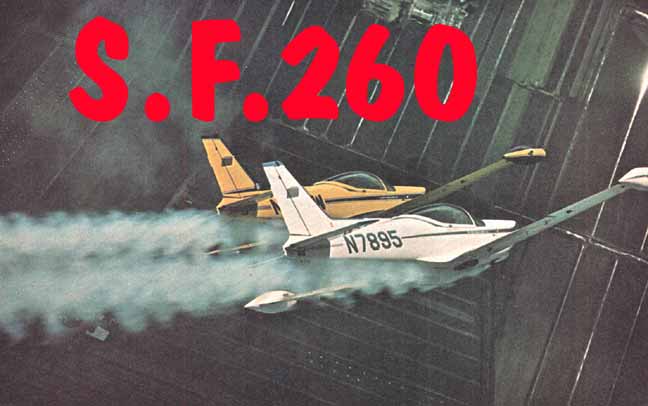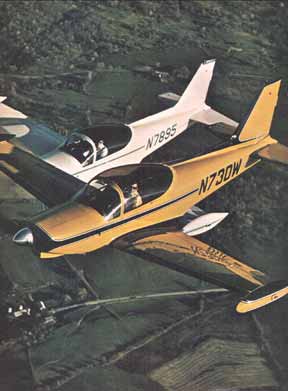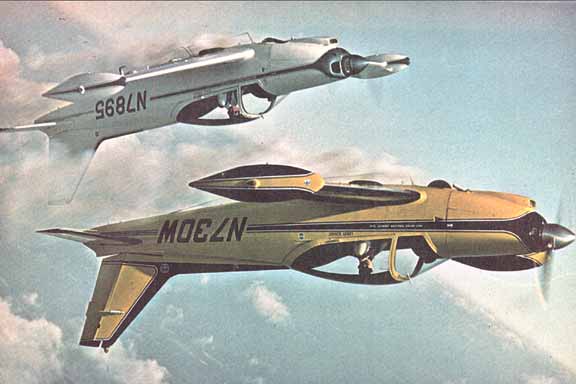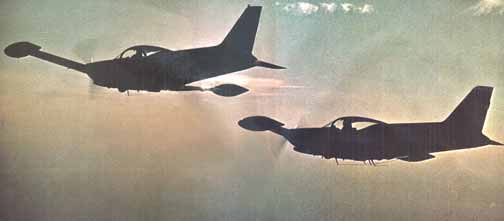
WACO
METEOR/S.F. 260
And still Champeen!
Story and photography by Budd Davisson, Air Progress, Sept. 1977
Editors note from 2006: The Siai-Marchetti S.F. 260 has matured into the aeronautical version of another Italian form of speed, the Ferrari. And like the Ferrari, the Marchetti is a timeless form with timeless handling. But it wasn’t always as well known and it wasn’t always known on this side of the pond as the Marchetti 260 (short hand version).
When it first hit these shores, believe it or not, but it was known as the WACO Meteor. Only three were imported under that name and because they were little known, they wound up either orphaned in hangars or left to rot on ramps. The two you’ll see here are largely responsible for the early rise of the breed because of their airshow activities and appearances in lots of magazines, including posing for one of only about a half dozen covers I shot for Flying magazine, which is hardly my normal venue.
It was through the Marchetti/Meteor that I was first exposed to a special breed of pilot that is so rare, it’s hard to explain exactly how good they are. These two, the late Larry Kingry (only cancer would possibly have enough power to slow him down) and Harry Shephard still rate as two of the finest pilots I’ll ever meet and Larry is easily one of the most unusual characters any of us will ever know. So, when this was written (1977) we were still pretty naive, but we were also pretty damn good. It’s hard to believe we would learn so much in coming years. Incidentally, if I ever hit the lottery, within 24 hours I’ll have an S.F. 260B in my hangar. Count on it!
Waco Meteor owners have a favorite game they play. It involves sneaking up along side a brand new Bonanza, a Viking or one of the much vaunted Meyers 200D's. Once in position, they look over at the other pilot and smirk a little, challenging them to a race. The challenge is always taken. As the victim buries his throttle in the panel and the airspeed stabilizes, the Meteor driver looks over, smiles and mouths a silent "Bye, bye," He then proceeds to walk away from the other airplane, probably doing a four-point roll just to rub it in. And it's such a visible lurch forward that the Bonanza/ Meyers/Viking owner usually starts checking to see that his flaps are up.
 |
|
It's especially humbling to know these two used
to fly hard IFR in this position. |
When speed is the name of the game and the engine isn't being force fed through a turbocharger. the undefeated champion is the Waco Meteor. An Italian thorough-bred with all the classic breeding and ill-manners of a Ferrari Boxer, the Meteor (aka Siai-Marchetti S.F. 260) was born to perform in three dimensions. Although its advertised cruise speed of 215 mph is only marginally higher than that of a new Bonanza or hot-rod Meyers, it's when the airplanes are side by side that one begins to suspect that Wichita advertising agencies have more imagination than facts at their disposal. With only 260 horses at the other end of the goknob, the Meteor can. and frequently does, blow the doors off of every civilian, normally aspirated single engine bird ever made. And that's the name of that tune!
The S.F. 260 was designed and nurtured by one of the world's very few true geniuses in high performance light aircraft design, Stelio Frati. Not hampered by a bureaucratic or corporate hang-up that demands all aircraft be designed to be flown by the absolute weakest link in the pilot community, Frati always designs an airplane to get the most performance out of the least horses. And he always succeeds. His airplanes are considered "hot" by most pilots, because they don't land at 50 mph and don't necessarily forgive the pilot if he's cross controlled all his turns within 5 knots of Vso. He designs beautifully exciting machines that go places and only ask that the pilot learn to fly, not drive, before he hops in and straps it on.
In the mid-1960's, an
enterprising and energetic gentleman in Pennsylvania decided to try a new
approach at building an aircraft empire. Rather than building aircraft, he
decided to pick the best designs Europe had to offer and import them under
the name WACO. Most of his choices were regrettable, if not forgettable. Only
the Socata Rallye (Waco Minerva) and the S.F. 260 (Waco Meteor) offered anything
not already obtainable in the American aviation marketplace, and even then,
the Minerva was marginal. The Meteor/S.F. 260 was not. Flown by various pilots,
most of them women, it immediately set several class records and showed the
way around at most of the races in which it was entered.
Unfortunately, the WACO Corporation floundered. Their products weren't necessarily
suited to the existing marketing environment and more importantly, were expensive
as hell. A 1969 brochure lists the S.F. 260 at $33,975 with nothing but wings
and an engine as standard equipment. To make a long. agonizing story short
and agonizing, the importing business went under, the founder passed away
and three S.F. 260's found themselves orphaned a long way from home.
After a few years, the three Meteors suffered different fates. The original
demonstrator. N730W, tired after having been raced, demonstrated and abused,
eventually wound up in the weeds at Whiteman Airpark in the upper San Fernando
Valley. N7895 belonged to a lady who loved it so much she seldom flew it and
it gathered dust and only 75 hours flying time in the first 5 or 6 years of
its life. The other airplane went from owner to owner before coming to rest
in Columbia, S.C., where its current owner. Bob Russel airshows and salivates
in it.
I guess I could be credited with saving 730 Whiskey from the bone yard. 1
spotted it at Whiteman, looking as forlorn as an Italian can look when stripped
down to its skivvies and left on a deserted ramp. I mentioned it to a hotrock
friend of mine who was looking for something with some zip, and within three
weeks it was back here on the East Coast, with Larry Kingry trying to pump
some life back into it. Then his partner, Harry Shepard, couldn't stand it
any longer so he went to Connecticut and bought N7895. the low time beauty
with only 75 hours. To shorten another extremely lengthy story, they spent
about a year pumping avionics and grotesque amounts of cash into their airplanes
to put together a formation acrobatic team, known locally and variously as
either "The Bobsy Twins" or "Captain Crunch and Precious Little."
 |
|
This was early in their career before they started
doing loops and rolls canopy to canopy with their vertical fins over
lapping. |
However, the Waco Meteor
story doesn't end right there, with three bastard machines stranded on foreign
shores. In recent years, two more have been imported by private individuals
who have a speed addiction, one of them based with The Bobsy Twins (properly
ShepKing Enterprises) at Andover-Aeroflex Field in New Jersey. Then, as if
you can't keep a good machine down (you can't) the brilliant history the S.F.
260 earned as an advanced trainer for various European air forces, caught
up with it, Now it is being marketed by Vantage Aircraft Corp. of Washington,
D.C., as a military multi-purpose machine for the Banana Republics. In this
role it has hard points for rockets or weapons pods, a taller rudder, jettisonable
canopy and the other accouterments needed to make a pretty civilian into a
nasty looking gunslinger. This machine will be available to bucks-up civilians.
The price isn't clear; however, it may be something like $130,000.
As it happens, I'm so close to the New Jersey Waco Meteors that they have
to move my Pitts every time they want out of the hangar. That's close! Harry
and Larry and their yellow and white S.F. 260's are legends around the airport
because of what they are capable of doing with their machines. As it happens,
to do their airshow routine has required them to teach their Meteors to eat
via injection systems and Christen inverted fuel and oil systems. They also
went to counter-weighted props. This has taken them out of standard category
and put them into experimental. No bother, though, since that allows them
to do their own maintenance, if necesssary.
 |
|
'Just doesn't get any prettier, does it? |
I don't know how many
times I've gone ripping cross-country with them, an extra tip tank painted
right in the middle of our windshield, since they don't feel safe flying further
than three or four feet apart. I've also spent a fair amount of time flying
both airplanes and on occasion have soloed Larry's when we had more airplanes
than pilots and I was pressed into service. However, I had always done only
what was necessary to do what had to get done, including the usual side trips
into rolls, loops and the like. It wasn't until recently that Harry got around
to giving me a proper checkout and let me play around with the airplane, experimenting
with its flight envelope and learning its good and bad points. Andbelieve
me, it's got plenty of both.
Mechanically, the weakest part of the Meteor is its landing gear retraction
system. It's super sensitive to rigging and even the slightest amount of adjustment
creep results in some very expensive noises. As if to prove a point, Harry
pointed out that his is the only one of the original airplanes not to have
been on its nose after the nose gear collapses on roll-out. The culprit is
an adjustable. spring loaded actuating rod that is either easily bent or misadjusted
The up locks also required some updating and the yellow bird of the duo had
the unfortunate distinction of having its gear come banging out during a four
G pull out, which ruptured everything within reach of the actuator mounting
brackets.
Because a Meteor sits so low, it's easy to check the fuel (18 gallons in each
tip, 13 in each main) but you have to slither around on your knees to get
under it to check sumps, gear wells, or clean the residue left by the smoke
system off the belly.
Climbing up on the airplane requires you to watch, where you plant your tootsies
because the wing walks are narrow, too narrow. More than one would-be passenger
has died an unnatural death when Harry caught them with their heels out on
the wing paint. You get down into the cockpit fighter style, hanging on the
windshield frame and swinging down in, guiding your feet down into the tunnel
under the panel. I've flown the airplane from both sides, but much prefer
saddling up on the right side because it feels absolutely obscene to be flying
with a stick in your hand and the throttle in the right. There is a factory
option, which all military versions have, that includes left side and center
mounted throttles so both pilots use their right hand on the stick.
Both of the Bobsy-Twin Meteors have been equipped to the hilt with every known
gadget you can put in a panel, including course-line-computers and, in Harry's
case, an auto-pilot. Not your average airshow machine here. Because of that,
it takes a while to spot the more necessary stuff like flap and gear switches
because they are innocuous little electric jobs that get lost in the blizzard
of switches. Since everything in Harry's panel is where Harry wanted it, there
isn't much purpose in describing the layout, since it is far from typical
Meteor.
The emergency gear extension system, which almost all Meteor owners find use
for occasionally, could stand improving. In the first place, you have to remove
a sizable section of the console between the seats. Then you are supposed
to crank for a specified number of turns, which Harry says is impossible to
do because you lose count when flying and cranking at the same time. Also,
the crank works through the electric motor, so a frozen motor would do the
same for the entire system. One nice aspect of the gear, although sort of
unusual for a high performance airplane like the Meteor, is that the wheels
protrude slightly when retracted. So, the belly just barely touches if it's
dropped in gear up.
Getting the big Lyc going requires a game called "Will it or won't it?"
Usually we're successful. but if it's hot, it takes some playing around. Boost
pump for a few seconds, mixture out. crank it over and hope it catches. When
it does, you are immediately aware of the small size of the airplane in regards
to the size of the engine. The machine is smaller than a Cherokee, with 260
horses to drag it down the taxiway. You also feel the engine weight on the
nose wheel because steering requires a healthy foot or two.
Where the engine/ airframe size ratio really impresses you is on takeoff.
Dropping the hammer gently by screwing in the vernier keeps you from getting
into too many torque problems, but no matter how you do it, it rockets down
the runway with a rush that's guaranteed to fill your hip pockets with adrenalin.
It wraps the airspeed up like a toy but at no time gives any indication that
it will fly off in a three-point position. At 80 mph you pick the nose wheel
off and it still sits solid on the rapidly disappearing runway and doesn't
fly itself off until around 90 mph. I can't verify that number because not
once did 1 catch the airspeed under 100 mph. once I had lifted the nose wheel.
About 12 degrees of flap
is used for takeoff and the unusual thing about them is that you can jerk
them in just as you would the gear. The second you're off the runway the gear
comes in and so do the flaps. The airplane is accelerating so quickly that
any tendency to mush when the flaps come up is unnoticeable because the airplane
sheds drag and picks up speed as they are being retracted.
Except that it happens in one hell of a hurry, the takeoff only requires carefull
attention to keep the centerline wired and to gently urge the nose wheel off
at 80 mph. From that point on, the Meteor is climbing so hard and fast that
all you have to do is hang on. To get the airspeed down to a dangerous level
would take a real knucklehead because the normal climb attitude is terribly
steep. If you put the nose where you would most other airplanes, You'll be
climbing at about 125 mph. One interesting thing about its climbout is that
it will easily top 1500 fpm at 90 mph which drops back to 600 fpm at 125 mph.
However, you can increase the speed all the way up to 155-160 mph at 25 inches
and 2500 rpm and still be climbing at 600 fpm. That's some kind of cruise
climb.
At altitude, the airplane can really reach inside you and grab you where it
counts. In the first place, I found that in using the old stand-by power settings
of 23 inches and 2300 rpm, we were indicating a solid 194 mph. At our altitude
and temperature that'd be about 210 mph TAS. The advertised top speed on the
machine is variously quoted as 215-225 mph but during a timid, closed course.
official run, both Shepard's and Kingry's airplanes hit 234 mph, which nearly
agrees with the handbook sea level max of 235 mph. When flying formation with
a cruising Bonanza or 210, we'd find that we were almost never using more
than 19 or 20 inches of manifold pressure. 55 percent on this airplane gives
something like 175 mph indicated! It's frightening! On a standard day, I've
gone scooting over the top of the New York TCA at 200 mph indicated at 75
percent. The Meteor sure can compresss geography!
But speed is far from being the Meteor's only virtue. I don't know of any
Frati designs that aren't acrobatic and the Meteor certainly falls in that
category. Its high-jinks are of the high speed category . . . big swooping,
incredibly smooth loops and rolls. Hammerheads are absolutely surrealistic,
because you can actually see the horizon creep up the tip tank and stop, asking
you to boot the rudder. You can come wafting over the top of a loop and just
gently tweak the stick and the airplane obediently breaks, snap rolling lazily,
but precisely into whatever you want. Going down hill. it packs mph into the
gauge so fast it's scary and it'll touch the 274 mph redline with only a little
urging. Speeds of 250 and 260 mph arc completely usual and you can suck it
up into a vertical roll from that speed that almost puts you out of sight
of the ground. It has power, it has speed, but most importantly, it has grace.
It also has all the handling characteristics of a fighter. At extremely high
speeds the usually responsive, but slightly hard ailerons turn to concrete
and large deflections require muscle. Also, with only 108 square feet of wing
area and a gross weight of 2430 pounds, it has a wing loading of 22.5 pounds,
which is 30 percent higher than a Bonanza and is equal that of early model
Spitfires.
Its 64 series laminar wing asks that you treat it gently because even a slight
amount too much g at slow speed will send you tumbling over the peak of the
lift curve into a sharp edged stall. Power off, at one g, dirtied up, the
stall will be clear down around 62 or 63 mph. But just the slightest amount
of pressure, like flaring too late and jerking, will run the stall speed up
to 75 mph or better.
There is a reasonable amount of pre-stall buffet that is introduced primarily
by stall strips on the root of the leading edge. Shepard says he once flew
it without those strips and found it' would suddenly stall out from under
you without the slightest warning. Not even a hint of what was about to happen.
Even though he's an exNavy F8 Crusader driver, he put the stall strips right
back on. And the airplane is happiest when flown like a fighter.
When landing, it takes miles to get it to slow down in the conventional manner.
Simply bringing the power back and holding altitude to slow down, will put
you in another country, chugging along at 150 mph with only 15 inches. By
far the best way to get it set up for lauding is to totally ignore the airspeed.
I found it extremely easy to handle the airplane Navy style, flying the pattern.
or parts of it at speeds as high as 220 indicated, then flying a 360 overhead
pattern, sucking it into a hard left turn right over the middle of the runway,
bringing the power back as I did. In that situation the "G" slows
the airplane very handily to the ridiculously low 125 mph gear speed.
Because of the sensitive
nature of the gear, Shepard likes to use 110 mph or slower as a gear extension
speed. Once the gear and 20 degrees of flap are hanging out, keeping the speed
down is no longer a problem. As a matter of fact. it's extremely easy to get
it too slow. Because of the excellent visibility. and the characteristics
of the airfoil and flaps, a slight, almost unnoticeable pitch will steal air
speed like crazy. Conversely, however, you can drop the nose to lose unwanted
altitude on final and the airspeed will almost not move at all. With flaps
that deflect to a whopping 50 degrees it almost has a built-in drag-chute.
It's very weird.
The rate of descent on approach must be astronomical power-off, so a goodly
bunch of horses are kept working at all times in the pattern. 100 mph is a
good number on final with a very solid 90-95 over the fence almost mandatory
for a pilot unfamiliar with the machine. Even when on top of it, 85 mph looks
an absolute minimum over the fence, unless its a very still day. This sounds
high, and it is, but the first time you try flaring it you'll see why you
want that kind of speed.
Even at 90 mph, you can't flare it like a "normal" lightplane without
it suddenly dropping out from under you a toot or so above the ground. 1 don't
know how much speed it takes to make a smooth, almost normal, power off flare,
but it must be over 100 mph. Shepard's method, and one I found comfortable
was to fly it almost into ground effect at a fairly steep glide angle, waiting
much longer than usual to flare, carrying some power all the time. Then, 1'd
flare rather quickly, bleeding the power off at the same time. The combination
seemed to work fine and decreased the amount of time I spent hanging on the
hairy edge of nothing. My earlier approaches,, fairly normal length and glide
angle, required a hell of a lot of power and seemed to demand an inordinate
amount of care while flaring.
Actually. I found the Meteor to be one of the most difficult airplanes I've
ever flown to make smooth landings in. In many ways it felt even more demanding
than a Mustang or Bearcat. both of which aren't quite as critical in ground
effect. It is in no way to be confused with a light airplane, such as a Bonanza
or 210. It is, in every possible way, a high performance, heavy machine and
had better be treated like one. It might let you abuse it for a while, but
keep doing it and sooner or later the airplane will turn around and take a
healthy chunk out of you.
Because of its
high performance style low-speed handling characteristics, later series S.F.
260’s have certain modifications aimed at trying to take some of the
bite out of it. This includes a modified airfoil section out towards the tip
that does away with a little of the sudden break characteristic and gives
better aileron control in and near the stall. The later ones also have a higher
rudder to add directional control needed when weapon pods are being used.
As a traveling. acrobatic, fun airplane, the Siai-Marchetti S.F. 260, aka
Waco Meteor, has almost no equal. Granted it's not a full tour place airplane
because the rear scat is placarded to 250 pounds, but when people start talking
speed the number of people don't seem to count. When it comes to getting there
first, in single engine airplanes, number two doesn't count and number one
will always be a Waco Meteor.
POWER
PLANT
One 260 HP Lycoming 0-540-E4A5 six-cylinder horizontally-opposed air cooled
engine.
Two blade, constant-speed Hartzell type HC-C2VK-1 BF/8477-8R propeller. Two
wing tanks:
total capacity 22 U.S. Gals. Two wing tip tanks'.
total capacity 32 U.S. Gals.
DIMENSIONS
Wing span 27 ft 4 3'4 in Overall length 23ft 3 1/2 in Height 7 ft 11 in
Wing area 108.7 sqft
WEIGHT
Empty weight, equipped 1,664 lb Useful toad 726 lb
Max T.O. weight 2,430 In Max power loading 9.3 lb no Max wing loading 22.35lb/sq
it
PERFORMANCE
Max speed at sea level 187 KTS Max cruising speed 178 KTS Stalling speed with
flaps 60 KTS Rate of climb 1,800 ft/ min Service ceiling 19,000 ft Take-off
run 1,837 ft
Landing run 1,132 ft Range 805 SM
For
lots more pilot reports like this one go to PILOT
REPORTS